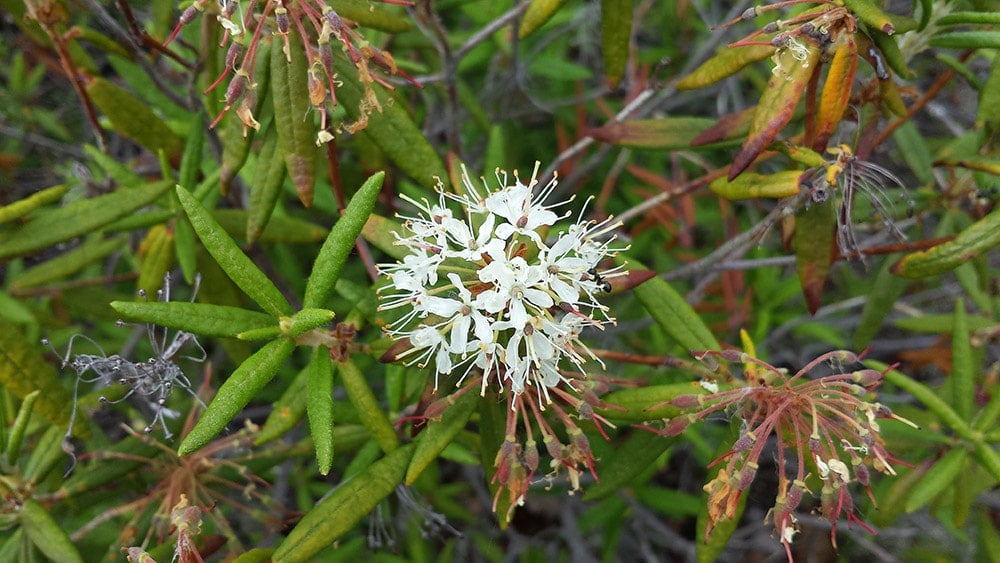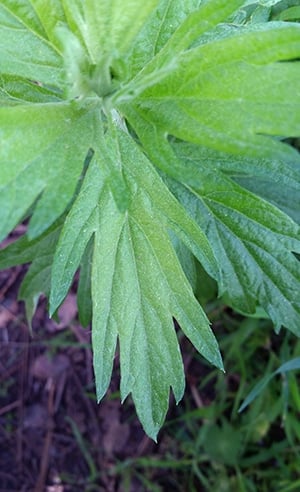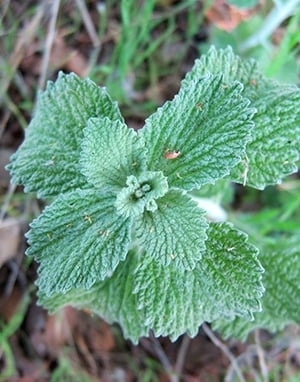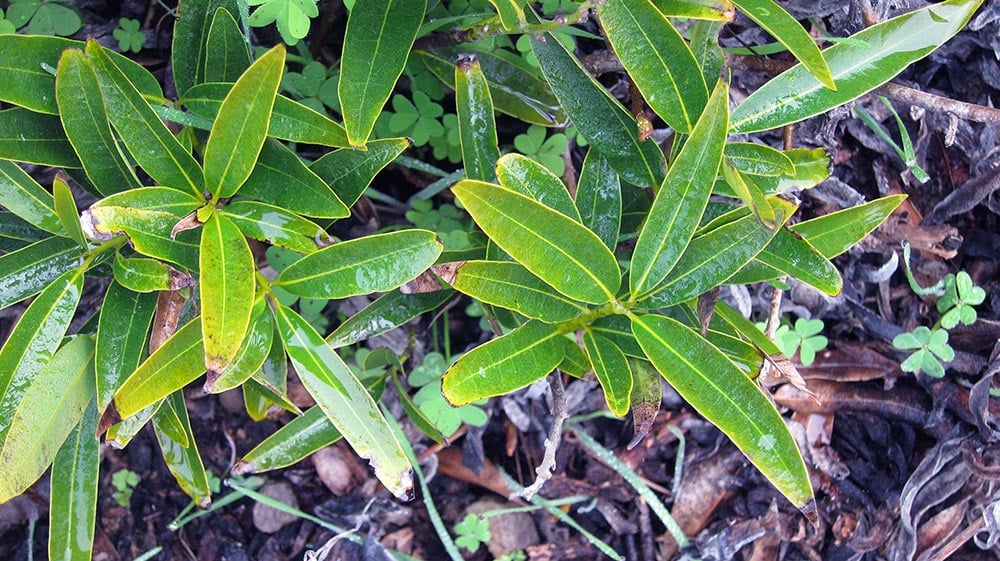As an Amazon Associate I earn from qualifying purchases.

Gruit. If the name sounds medieval, that’s because it is. Pronounced groo-it, this style of beer is defined as one either not using hops at all, or which employs hops as only one of many herbal additions to the brew. It is an ancient way to brew beer, dating back to the origin of brewing at least 6000 years ago, although the specific amalgam of herbs that came to be called gruit is more of a Dark Ages and Medieval thing. For foragers like myself, the idea of a beer made with the wild edible plants that live all around us sets my mind racing.
Let me start with a bit of background. Beer is made from grains that have been malted — partially germinated and then dried, so their starches turn to sugar and stay there — crushed and steeped in hot water to make a sweet grain tea we call wort, which is then boiled, cooled and allowed to ferment. Only in early English ales was nothing more added. Evidence strongly suggests that in most cases something else — something herbal — went into that boiling pot, even dating back to the Sumerians, Babylonians and ancient Egyptians. One reason is because beer made without an herbal addition is cloyingly sweet; think of a milk stout or seriously malty dark beer and you get a whiff of how sweet a beer can get.
The answer? Add something bitter to the mix to balance things out. Given human imagination, you can bet that someone somewhere has tossed in pretty much everything, from known edible or medicinal herbs to fruit and vegetables, to weirdness like mutton and eggs and crab eyes. Seriously. I did not just make that up.
Once you sift through the bizarre, as well as the plants that add flavor but not bitterness, like ginger, you get a set of mostly medicinal herbs. After all, bitter is often an indicator of toxins, which, in small, controlled doses, are what we humans call medicine. Now, go one step further. A great many bitter, medicinal herbs happen to also have serious antimicrobial, preservative powers — so adding these to beer not only balances out the flavor, but also helps keep the beer from spoiling. Spoiled beer is sour in a way you don’t want to drink, even if you happen to be a fan of Belgian sour beers. Nasty stuff.
In the grand cage match between herbs that both bitter and preserve, hops, Humulus lupulus, won the fight. Contrary to the views of popular authors such as Stephen Harrod Buhner, whose book Sacred and Herbal Healing Beers: The Secrets of Ancient Fermentation serves as a font of anti-hop propaganda, the overwhelming weight of scientific and historical evidence shows that hops will preserve a beer longer than other medicinal herbs — and that this has been known in some quarters as early as 822. The northern German towns of Bremen and Hamburg were making bank by exporting hopped beer by the mid-1200s, some 250 years before the famed reinheitsgebot purity law passed in Bavaria in 1516; this is the law that requires all beers in Bavaria contain only malt, water and hops. Even in England, a fairly late hold-out against heavily hopped beers, was importing hops in brewing quantities as early as the 900s. I mention all this because Buhner’s book posits the theory that it was the Protestant Reformation that killed gruit-style beers in the 1500s. This idea simply lacks evidence.
Enough history. To be sure, I am no enemy of the hop. Some of my best friends are hoppy beers… But, Buhner and others are indeed correct when they point out that hops are a rather powerful sedative, whereas most of the traditional gruit herbs are not.
So what are those herbs? It is generally accepted that bog myrtle, Myrica gale, was the main ingredient. But gruit was a cocktail of herbs jealously guarded by medieval authorities, who taxed the herb mix and required that it be the only legal additive to beer. They could get away with this because most of the land where these herbs grew was swampy and unfarmable — and, well, possessed by the chruch. Incidentally, when hops came along, the authorities just started taxing beer by the barrel.
Wild rosemary, Ledum paulstre, is also mentioned quite a bit. This one has been recently reclassified as Rhododendron tomentosum — what many of us know as Labrador tea. (Labrador tea is also the common name for related plants Rhododendron groenlandicum and Rhododendron columbianum.) There is some speculation that brewers used Lab tea when they couldn’t get bog myrtle, as the two plants often live side by side.

After that, things get murky. While Buhner’s book may be a bit strange in its anti-hop crusade, it is absolutely invaluable as a guide to herbal beers — European and otherwise. He provides evidence and recipes for beers balanced and flavored with medicinal herbs throughout the book, and writes that the other gruit herbs possibly included some of the following:

- Yarrow, Achillea millefolium
- Mugwort, which is in the sagebrush or artemisia family. There are lots of species.
- Regular garden sage as well as clary sage, Salvia sclarea
- Horehound, Marrubium vulgare
It is well known that all these herbs have antimicrobial powers, which would help preserve beer. We still eat horehound cough drops — or you do if you suck on Ricola cough drops; horehound it its chief constituent. Yarrow, as it happens, is one of the best blood coagulants known to man. And sage is not called “salvia” for nothing.
What’s more, adding these herbs to a beer may well give you a very different buzz than you’d get from drinking a hopped beer. Our local variety of mugwort, Artemisia douglasiana, is also called dreamweed: Ingesting it in small doses can promote vivid dreams. There isn’t a lot of actual science behind the idea that yarrow is psychotropic, but there does seem to be enough anecdotal evidence to suggest that something different happens when yarrow meets alcohol. There is, however, plenty of science to show that Labrador tea, taken in sufficient quantities, is indeed psychoactive.
So brewing a gruit could be an, ahem, enlightening experience. I’ve done two so far, one without hops, the other with a bit of mild Saaz hops. The first included mugwort, St. John’s wort and horehound, and was, well… undrinkable. Fiendishly bitter, even for me, while at the same time tasting thin. Not a good combo. Still, I will hold onto some bottles to see if it changes over time.

The second attempt, the one with the touch of hops, is better. It has a smaller percentage of gruit herbs, and I switched to a mix of mugwort, Labrador tea and California bay laurel; European bay laurel was commonly added to beer in the Medieval period. It too needs time to age, but I have a better feeling about this brew.
Buhner goes well beyond Medieval gruit to list a litany of herbal beers that open the mind to endless possibilities. Heather ale — or one with the young flowering tips of Scotch broom, a pernicious weed here in California. Beers with wild fruits added. Beers with any and all forms of conifer; spruce and fir and pine bear a strong resemblance to hops in aroma, and their high Vitamin C content will help preserve the beer. Our nearby Moonlight Brewing Co. in Sonoma County makes a dark beer with the fresh new growth of redwood called “Working for Tips.” Spruce tip beers are becoming increasingly common elsewhere, too.
As I embark on this wild brewing adventure, I have to tip my cap to my friend Pascal Baudar, a fellow forager living in Southern California whose new book The New Wildcrafted Cuisine: Exploring the Exotic Gastronomy of Local Terroir, includes a large section on herbal and wild brews, including non-alcoholic sodas. If you want to get into this game of foraged and wild brewing, you could do worse than start with Pascal’s book.
I am brewing an elderflower saison beer as I write this. And, as there happen to be California relatives of bog myrtle, Labrador tea and another possible gruit herb called meadowsweet, Filipendula ulmaria, my experiments with a truly local, California gruit will continue. And you can bet that once I get a recipe I love, I’ll share it with you here. Meanwhile, to the brewers out there: What’s your experience with beers using wild ingredients?





Just started a 5 gal batch with mugwort, bog myrtle, yarrow, and heather. Split the first 3 :1/2 and 1/2 @40 minutes and 3 minutes- all the heather went in at 3 minutes. 6 lbs of amber malt extract and 1+ (5cups) of wildflower honey at flameout. Smelled great! Fingers crossed.
My friend and I were inspired by this post, and just finished bottle conditioning our first Gruit beer – we used Mugwort, thyme, rosemary, anise hyssop and lemon balm with a Saison yeast. It’s actually drinkable!
Butch your beer list looks amazing! I wish I wasn’t across the country so I could sample a flight! We have some young sea buckthorns that should produce berries next year…might have to give them a shot?
Into herbal beers? You might get a kick our brewery: eartheaglebrewings.com
Check out the “draughts” tab and the “big list” under it.
Cheers!
-Butch
Agrarian Ales in Eugene, Oregon is doing some interesting things outside of growing their own hops. I had their Dandy Lion Porter the other day. Made with roasted dandelion roots. It was quite tastey.
David Spahr uses Reishi mushrooms (Ganoderma ssp.) as the bittering agent in an IPA. I haven’t used it for that, but the tea produced by boiling the dried fruiting bodies in water for an hour or so is incredibly bitter, so it’d probably work well to balance the sweetness of the malt while adding some medicinal benefits, as well.
The hardest part seems to be managing quantities—I’ve had the same issues with homemade amari (though the one I brought up to your hunting trip at Suisun Mrash wasn’t too bad). I brewed a very lightly hopped weizen-ish beer with a couple of ounces of dried calendula flowers in it. I wish I could say you could taste or smell the spicy flowers… but not a even a little.
Good luck with the saison!
Interesting stuff. I did a brew about 2 years ago with wormwood. From memory it was a basic draught kit and I added a sprig of fresh wormwood like you would dry hop.
For the first few months it was super bitter and almost undrinkable, but after 12 I wished I hadn’t opened all those bottles trying it! It mellowed right out and was delicious.
I do cider from mixed wild apples which is hit and miss.. but if nothing else it makes amazing vinegar. This year I really went to town with some wine making and had a go at dandelion. Which is. .well.. interesting. Lets say its somewhat herbal, but I actually quite like it.
This read also reminds me of a beer I had a few years ago here in Australia. Not sure of the quantities or process but it was dark, delicious and claimed to be brewed from a percentage of acacia seeds.
Going to have to research that one I think.
Thanks Hank, this is very cool. I am a brewer at a NorCal brewery and while we have to brew plenty of our mainstream favorites, there are always a few experimental brews fermenting or aging in a corner. I know that our head brewer has done a gruit bittered ale at one point, but I’m not sure what the recipe was.
One clarification, malting grain doesn’t convert the starch to sugar. That happens during the mash when the grain’s enzymes go crazy and make that happen. If you “stew” and heat the malted grain like with crystal malt, then that conversion has happened and you have sugars in the grain (which you can steep, etc). But the main malt in a beer is pale malt which needs a mash to convert.
Cheers!
Glenn: Good point on the mashing process. But malting gets the grain ready to give up its sugars.
How did the elderflower Saison turn out? Have a pound of elderflower and yarrow flower to be combined with milky oat mash.
Great share, thanks for the post! Love your blog!
My main “wild” brew is Finnish sahti. I’m contemplating whether to rack my latest batch tonight, perhaps reserving a bit during transfer as a toll for the brewer. Juniper is a natural with game so this is a beer made for venison (and reading the Kalevala, for that matter).
I used to make a fair amount of mead, which would be a natural pairing with medicinal herbs (known as metheglin). However, I never tried anything from the wild…honey being so expensive these days it’s harder to take a risk. I’ve planted elderberry bushes and black cherry trees on our land in hopes of either attracting deer or having some fruit for meadmaking, but if you plant it in the wild, does that count as proper foraging? 🙂
My last year’s experiment making nocino from black walnuts failed miserably, and I’m wondering if the nuts were just too far past their unripe prime, or perhaps I’m not a fan of nocino, but a stout made with unripe black walnuts might be interesting. Perhaps not brewing with them, but adding a maceration of them (ie., nocino) to the fermentor after most the fermentation had ceased would be interesting.
I thought briefly about acorns, but thought again. That’s a lot of work and the fat content alone would be a problem. Right now I think I’m more amenable to using wild ingredients as flavoring for beer (wild herbs, juniper, fruit) rather than a fermentable base. Now if I ever move to place where there is aspen, I may have to chop one down and make a kuurna, the traditional sahti lauter tun made from half a hollowed out log!
Awesome. Looking forward to reading about this. Hank, have you given any thought to using any wild grains/tubers/nuts for a source of starch/sugar for brewing?
AE: I’ve thought about it, but that’s a hard one. Collecting enough, then threshing, then malting, drying and kilning… big project. Only one I’ve thought about seriously is wild rice.